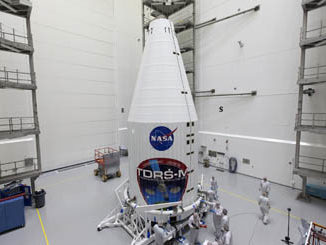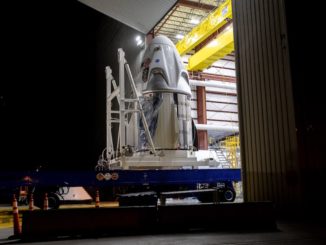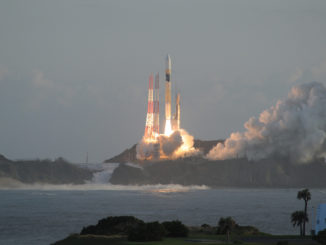
A decade in the making, the core stage for NASA’s first Space Launch System heavy-lift rocket rolled into the Vehicle Assembly Building at the Kennedy Space Center Thursday to join up with twin solid rocket boosters and an Orion capsule for an unpiloted test flight around the moon.
Clad in orange foam thermal insulation, the 212-foot-long (64.6-meter) rocket rolled off NASA’s Pegasus barge Thursday morning on a transport cradle driven by a self-propelled mechanism that carefully drove the core stage the nearly half-mile distance from the Turn Basin to the south door of the VAB.
Ground teams took their time with the operation, moving the rocket along at a glacial pace after an issue with the self-propelled transporter delayed the start of the offload from the Pegasus barge by about three hours.
Finally, the rocket emerged at around 8:30 a.m. EDT (1230 GMT) Thursday from the Pegasus vessel, a specially-designed barge that once hauled external fuel tanks for space shuttles from their factory in New Orleans to the Florida launch site. NASA extended the length of the barge to 310 feet (94.4 meters) to fit the longer SLS core stage.
The Boeing-built core stage measures 27.6 feet (8.4 meters) in diameter, the same width as the shuttle external fuel tank. The gigantic core stage contains reservoirs that will hold more than 730,000 gallons of super-cold liquid hydrogen and liquid oxygen propellants for launch.

Four Aerojet Rocketdyne RS-25 engines are affixed to the rear of the core stage. All four engines are veterans of multiple space shuttle missions.
Engineers test-fired the four RS-25 engines for eight minutes March 18 at the Stennis Space Center in Mississippi, the same duration they will burn during a real launch. The hot fire was a final development test intended to iron out any glaring issues on the core stage before the first SLS test flight, known as Artemis 1.
Officials at Kennedy are eager to start working with the core stage inside the VAB. The two 177-foot-tall (54-meter) solid rocket boosters for the first SLS test flight, supplied by Northrop Grumman, are fully stacked on the rocket’s mobile launch platform in High Bay 3 inside the Vehicle Assembly Building.
With the core stage now at Kennedy, technicians will complete refurbishment of the rocket’s foam and cork insulation, which suffered some expected damage after the eight-minute RS-25 engine test-firing last month. Ground teams at Kennedy will also install ordnance to be used on the rocket’s flight termination system, which would activate to destroy the rocket if it flew off course and threatened the public during launch.
NASA aims to be ready by the end of May to rotate the rocket vertical and lift it by crane into High Bay 3. A crane operator will carefully lower the core stage in between the two SLS solid rocket boosters.
Workers will connect the core stage with each booster with braces at forward and aft attach points. Next will be stacking of the SLS upper stage, derived from the second stage used on United Launch Alliance’s Delta 4-Heavy rocket, and an adapter that will support the Orion spacecraft.
The rocket will be crowned with a mass model of the Orion spacecraft for structural resonance testing of the fully-stacked launch vehicle. Once that is complete, teams will move the real Orion spacecraft — already integrated with its launch abort system — to the VAB for attachment to the top of the Space Launch System.
The fully-assembled Space Launch System and Orion spacecraft will stand 322 feet (98 meters) tall. During launch, the rocket’s four RS-25 engines and twin solid rocket boosters will generate 8.8 million pounds of thrust. It can send about 59,500 pounds (27 metric tons) of mass to the Moon, more than any rocket operating today.
NASA plans to roll the Space Launch System out of the Vehicle Assembly Building for the first time as soon as August — but more likely in the fall — to travel to pad 39B for a countdown rehearsal. The launch team will load super-cold liquid hydrogen and liquid oxygen propellants into the rocket and practice countdown procedures.
After that is done, the rocket will return to the VAB for final checkouts and preparations, then will roll out to pad 39B again for launch.

Steve Jurczyk, NASA’s acting administrator, said Tuesday that the agency still hopes to launch the Artemis 1 test flight by the end of 2021.
But he acknowledged the schedule was “challenging” to pull off the launch this year. A delay of any major milestone would put the launch date in jeopardy and slip the Artemis 1 mission to early 2022.
A second SLS/Orion test flight in 2023 will carry three NASA astronauts and a Canadian crew member around the moon and back to Earth. That mission, Artemis 2, will be the first time humans travel beyond low Earth orbit since the final Apollo moon mission in 1972.
Future Artemis missions will send astronauts back to the moon, and eventually land the first woman and the first person of color on the lunar surface, according to NASA.
The agency says the Space Launch System and Orion spacecraft are critical to the Artemis moon program, alongside a commercial human-rated lunar lander being developed by SpaceX, and a mini-space station to be placed into orbit around the moon.
But the programs, particularly the SLS, have faced years of delays and billions of dollars in cost overruns.
NASA started initial work on the Space Launch System in 2011, then eyeing an inaugural launch in 2017. As of June 2020, NASA had obligated $16.4 billion on the SLS program since its inception, according to the agency’s inspector general.
Additional photos of the SLS core stage’s offload Thursday are posted below.

























Email the author.
Follow Stephen Clark on Twitter: @StephenClark1.



